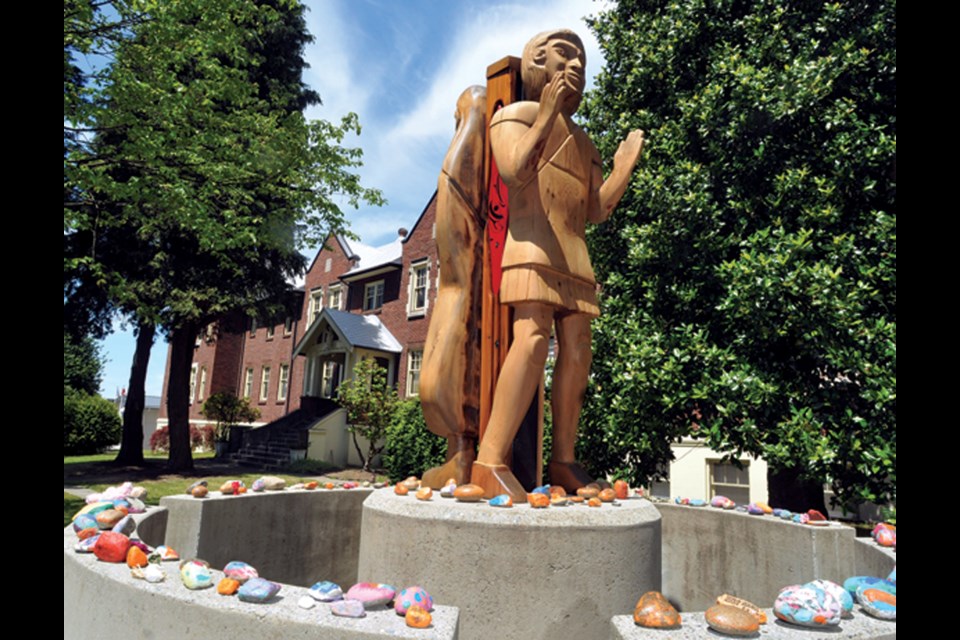The refurbishment of the St. Paul’s Residential School Memorial has been completed with the statues re-erected during a ceremony last week (June 17), after the memorial was vandalized in January.
“The ceremony was fitting, and comforting, and very timely,” Sḵwx̱wú7mesh Úxwumixw (Squamish Nation) spokesperson Sxwíxwtn (Wilson Williams) said.
Bringing together a huge cross-section of the community, residential school survivors were joined by Elders, students from local North Vancouver schools, municipal councillors, and leaders from St. Thomas Aquinas Regional Secondary School (which now stands in place of St. Paul’s).
“It made for a more meaningful ceremony,” Williams said. “It was comforting to have that kind of reach. And the ceremony itself was not only educational to everyone there, but it was very powerful.
“To have drummers and singers there, we had people being held up with traditional work … being blanketed, for not only the artists that did it, but the people that were a part of this monument from the beginning,” he said.
The carving outside the former Sisters of St. Paul convent on Sixth Street memorializes the more than 2,000 children from the Sḵwx̱wú7mesh (Squamish), səl̓ilwətaɁɬ (Tsleil-Waututh), shíshálh (Sechelt) and xʷməθkʷəy̓əm (Musqueam) Nations who were taken from their parents and forced to live at St. Paul’s Residential School.
Still unsure of who vandalized the monument or why, Williams said the RCMP Integrated First Nation’s Unit were respectful in their investigation to allow the nation to receive back the monument and move forward in a good way.
There was no “scheduled urgency” to re-erect the monument during June, which coincides with National Indigenous History Month, Williams said, explaining that it was important for the monument to be refurbished with good feelings.
“It was fitting that it was done before [National] Indigenous [Peoples] day, but also, the change of seasons, as if we look at it as Indigenous, since time immemorial, we've been surviving off the earth through the seasons of the year, so changing from spring to summer was very enlightening,” he explained.
One of the original artists to work on the monument, Jason Nahanee, told the North Shore News while working on the monument in April that they have to be very careful doing the “fine and dusty” refurbishment work, as the monument is seven years old.
“So there’s a little bit of stuff you have to get off there while you’re sanding,” he said. Taking the two figures from the monument down and working on them at his house in Eslha7an (Mission 1), Nahanee and his son Nathan, grandson Ryan Natrall and girlfriend Keely Harris worked to bring the monument back to life.
“The weather is pretty harsh around here sometimes. … We're just sort of taking our time to make sure we get all the cracks and holes filled on the human figures, and we're going to get them repainted to preserve them for the future,” Nahanee said.
Williams sent love, strength and prayers to Nahanee and his family who undertook the restoration work.
“Through the perseverance and history, and the strength we have, we look at this in a healthy way -- even the monument being vandalized brought our people together.
“Even though it triggered people into the residential school issue of the past, it brought our people together. And it really showed on the day we had the ceremony, but also through the days leading up.… I can't praise more [Squamish Nation rights and title director] Peter Baker and his team, because they really did it the right way. And they didn't rush anything. They utilized our teachings and practices in walking softly with our people,” Williams said.
Williams said the journey behind reconciliation is education, and the monument is just one education piece.
“We're looking at the four corners of teaching the world what really happened here and coming out of the dark history. And to be able to come out of it, is education and awareness and having an open heart and mind to accepting the truth. Because we're on that journey to educate our youth, as well,” he said.
Charlie Carey is the North Shore News' Indigenous and civic affairs reporter. This reporting beat is made possible by the Local Journalism Initiative.




